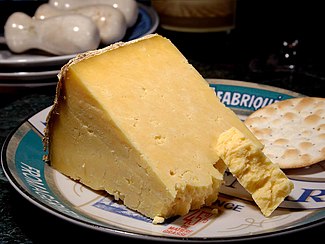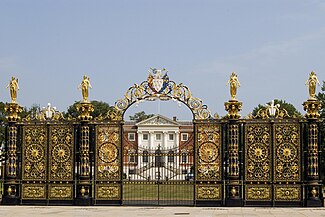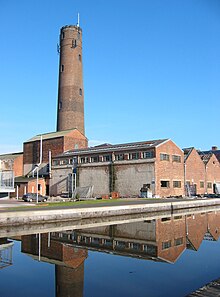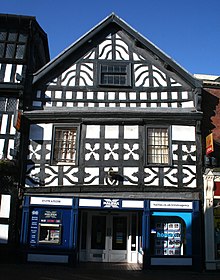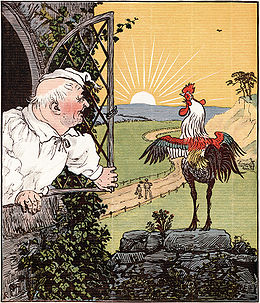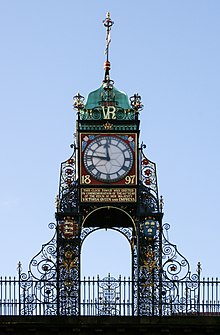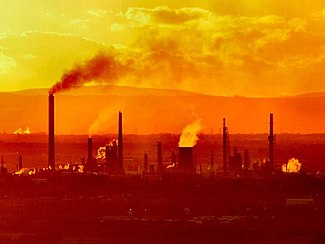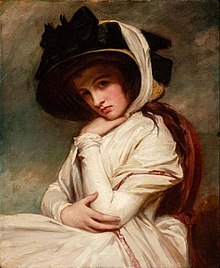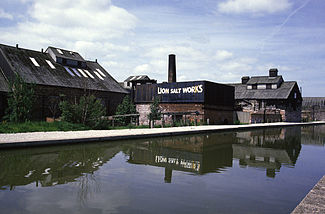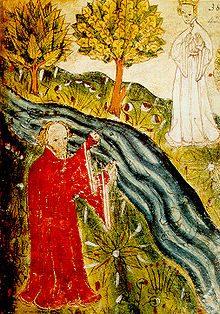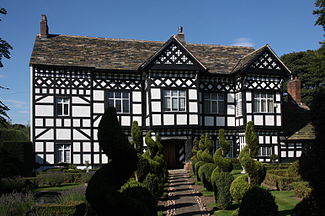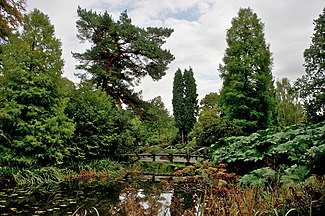Portal:Cheshire/Selected picture/Archive
The following images are currently featured as the Selected picture of the Cheshire portal. (Former Selected pictures are archived here.) To suggest an image for inclusion, use the suggestions page
| Portal:Cheshire/Selected picture/1
The Manchester Ship Canal took six years to build and cost about £15 million (now around £1.7 billion). This painting shows the construction of Eastham Dock. Credit: Benjamin Williams Leader (1891) |
| Portal:Cheshire/Selected picture/2
Scene from Alice's Adventures in Wonderland, in a panel at All Saints' Church, Daresbury, honouring Lewis Carroll, whose father Charles Dodgson was the priest (1827–1843). It was designed by Geoffrey Webb, based on John Tenniel's illustrations. Credit: Peter I. Vardy (7 April 2007) |
| Portal:Cheshire/Selected picture/3
Arley Hall, near Lymm, is the seat of Viscount Ashbrook. The original 15th-century timber-framed building was replaced in the 19th century by a brick hall, designed by Nantwich architect George Latham and modelled on various Elizabethan buildings. Credit: Pixie2000 (26 October 2006) |
| Portal:Cheshire/Selected picture/4
The Church of St James and St Paul at Marton, founded in 1343 by Sir John de Davenport and his son Vivian, is one of the oldest timber-framed churches in Europe. Traces of an early medieval painting of the Last Judgement were discovered in 1930. Credit: Richard Slessor (10 April 2004) |
| Portal:Cheshire/Selected picture/5
The dense and crumbly Cheshire cheese is one of the oldest named British cheeses, being first documented in around 1580. It has a mild, salty taste. Credit: Jon Sullivan (18 May 2006) |
| Portal:Cheshire/Selected picture/6
Warrington Town Hall, built in 1750, was formerly the Georgian country mansion of Bank Hall. It was sold to Warrington council in 1870. The elaborately ornamented gateway, known as the Golden Gates, was exhibited at the London Exhibition of 1862. Credit: Racklever (22 July 2006) |
| Portal:Cheshire/Selected picture/7
Built in 1799, Chester Shot Tower is probably the oldest remaining shot tower in the world and was used to manufacture lead shot for the Napoleonic Wars. Lead was exported via Chester during the Roman period and the lead industry flourished in the city during the 19th century. Credit: Espresso Addict (3 February 2007) |
| Portal:Cheshire/Selected picture/8
Many of the listed buildings in the centre of Nantwich are half-timbered, black-and-white buildings built shortly after the Great Fire of 1583. This single-gabled example on the High Street, adjacent to the Crown Hotel, displays decorative panelling and a second-storey jettying. Credit: Espresso Addict (11 August 2007) |
| Portal:Cheshire/Selected picture/9
Stretton Watermill is a working water-powered cornmill at Stretton, which originally dates from the 16th and 17th centuries. The mill closed in 1959, but was restored in 1967 and is now open to the public. Credit: Joopercoopers (21 March 2008) |
| Portal:Cheshire/Selected picture/10
Wood-block print, an illustration for "The House That Jack Built" (1878), the first of sixteen children's picture books by Chester-born artist Randolph Caldecott (1846–1886). Caldecott's work has been credited with heralding the modern concept of the picture book. |
| Portal:Cheshire/Selected picture/11
The Eastgate Clock in Chester dates from 1899 and commemorates Queen Victoria's diamond jubilee. It is said to be the second most photographed clock in England. Eastgate stands on the site of the original entrance to the Roman fortress of Deva Victrix. Credit: Mike Peel (www.mikepeel.net) (6 January 2008) |
| Portal:Cheshire/Selected picture/12
White Nancy stands on Kerridge Hill overlooking Kerridge and Bollington, whose logo it forms. The summer house or folly dates from 1817, and celebrates the British victory in the Battle of Waterloo. It is a prominent landmark on the Gritstone Trail. Credit: Walter Menzies (11 August 2007) |
| Portal:Cheshire/Selected picture/13
Stanlow Refinery at Ellesmere Port, near the River Mersey, has its origins in a small bitumen plant established in 1924. The complex now employs 800 people and handles 12 million tonnes of crude oil annually. Credit: Peter Gordois (24 October 2006) |
| Portal:Cheshire/Selected picture/14
Three Shires' Head on Axe Edge Moor is the point at which Cheshire, Derbyshire and Staffordshire meet. The old packhorse bridge over the River Dane suggests that silk was carried from Hollinsclough in Staffordshire to the mills in Macclesfield via this spot. Credit: Rob Bendall (3 June 2009) |
| Portal:Cheshire/Selected picture/15
Sir Thomas Grosvenor, 3rd Baronet (1655–1700) was the MP for Chester and served as the city's mayor in 1685. He was the first member of the Grosvenor family to have a substantial house built on the site of the present Eaton Hall; building started in 1675 with William Samwell as the architect. This portrait by Peter Lely dates from 1678.
|
| Portal:Cheshire/Selected picture/16
Eaton Chapel was built in 1869–84 for Hugh Grosvenor, 1st Duke of Westminster, as the private chapel for Eaton Hall. An example of the Gothic Revival style with Alfred Waterhouse as the architect, the grade-I-listed chapel was retained when Waterhouse's hall was demolished in the 1960s. Credit: Peter I. Vardy (4 April 2010) |
| Portal:Cheshire/Selected picture/17
The crags of Raw Head in the Bickerton Hills are a geological Site of Special Scientific Interest. The sandstone was deposited in the Triassic era, 250 million years ago. Credit: Vertigogen (16 November 2008) |
| Portal:Cheshire/Selected picture/18
This 17th-century map of "The County Palatine of Chester" by Wenceslaus Hollar (1607–77) shows the county's seven hundreds. These administrative divisions, first recorded in the mid-13th century, originated in the twelve hundreds of the Domesday survey. |
| Portal:Cheshire/Selected picture/19
Sometimes referred to as "the Matterhorn of Cheshire", Shutlingsloe is the county's third highest peak, with an elevation of 506 metres. In the east of the county, it stands on the edge of the Peak District, near Macclesfield Forest. Credit: Ian Warburton (4 March 2006) |
| Portal:Cheshire/Selected picture/20
Emma, Lady Hamilton (1761–1815), best known as the mistress of Horatio Nelson, was born at Ness, the daughter of a blacksmith. Renowned for her beauty, she became the muse of portraitist George Romney, inspiring more than 60 pictures. This portrait dates from 1785. |
| Portal:Cheshire/Selected picture/21
Delamere Forest is the remnant of the medieval Forests of Mara and Mondrem, which stretched from the Mersey almost to Nantwich in the 11th century. At around 2,400 acres, it is now the largest area of woodland in Cheshire. Credit: David Crocker (24 October 2004) |
| Portal:Cheshire/Selected picture/22
The Cat and Fiddle Road, which connects Macclesfield with Buxton in Derbyshire, has frequently been named the most dangerous road in Britain. The Cat and Fiddle Inn stands at the road's high point of 515 metres; it is the second-highest pub in England. Credit: Philip Halling (16 February 2008) |
| Portal:Cheshire/Selected picture/23
The Cheshire Regiment was formed in 1881 from the 22nd (Cheshire) Regiment of Foot, created in 1689 by the Duke of Norfolk. It suffered 8,420 casualties during the First World War; this picture is from the Battle of the Somme of 1916. Credit: Lt. J. W. Brooke (July 1916) |
| Portal:Cheshire/Selected picture/24
Opened in 1840, the Crewe railway works employed 20,000 people at their height. Over 7,000 steam locomotives and hundreds of diesel locomotives were built there. During the Second World War, the works also produced Covenanter tanks. Credit: Unknown (c.1890) |
| Portal:Cheshire/Selected picture/25
The Shropshire Union Canal was completed in 1835, with Thomas Telford as the engineer. The main line connects Wolverhampton and Ellesmere Port. The canal now forms a popular recreational route as part of the Four Counties Ring. Credit: Mari Buckley (February 2007) |
| Portal:Cheshire/Selected picture/26
1–5 Pillory Street, the newest of the listed buildings in Nantwich, was built in 1911 as a grocer's shop. The unusual building, in the French Baroque style of the late 17th century, was likened by contemporary observers to the Lusitania liner. Credit: Espresso Addict (29 October 2006) |
| Portal:Cheshire/Selected picture/27
Salt-making by the open-pan method dates back to the Roman occupation, and was one of Cheshire's major industries. The Lion Salt Works was the last place in the county to use the method. It closed in 1986, when this picture was taken, and is now a museum. Credit: Chris Allen (8 June 1986) |
| Portal:Cheshire/Selected picture/28
The 14th-century author of Sir Gawain and the Green Knight and Pearl, among other poems, wrote in the Cheshire dialect. He is believed to have been a native of east Cheshire or west Staffordshire, perhaps a member of the Massey family. This illustration from the Pearl manuscript shows the author (left) in the role of the father. Credit: Unknown (14th century) |
| Portal:Cheshire/Selected picture/29
Elizabeth Gaskell's novel, Cranford, serialised in 1851–53, is set in a fictionalised version of Knutsford, where Gaskell grew up. Gaskell describes many Cheshire customs in her works. Credit: Sybil Tawse (1914) |
| Portal:Cheshire/Selected picture/30
Mary Fitton (1578–1647) of Gawsworth Hall was maid of honour to Queen Elizabeth I. She is sometimes identified as the Dark Lady of Shakespeare's sonnets, based on her affair with William Herbert, Shakespeare's patron and a candidate for the Fair Youth. Credit: Unknown (c.1595) |
| Portal:Cheshire/Selected picture/31
The chimney-piece from Tabley Old Hall, now ruinous, is displayed at nearby Tabley House. It dates from 1619, and is in painted and gilded wood, with carvings including statues of Lucretia, Cleopatra and a female nude reclining on a skull. Credit: Peter I. Vardy (April 2010) |
| Portal:Cheshire/Selected picture/32
This caricature of Hugh Grosvenor, 3rd Marquess of Westminster, by "Ape" appeared in Vanity Fair in 1870 with the caption, "The richest man in England". He spent freely in Cheshire, building a new Eaton Hall at a cost of £803,000 (now £60 million) and commissioning around 400 buildings on the estate, in the nearby village of Eccleston and in Chester. Credit: Ape (16 July 1870) |
| Portal:Cheshire/Selected picture/33
The Bentley Crewe plant in Crewe opened in 1938, manufacturing Rolls-Royce Merlin aircraft engines during the Second World War. Bentley cars have been made there since 1946. Credit: Dan Smith (October 2005) |
| Portal:Cheshire/Selected picture/34
Lewis Carroll popularised the Cheshire Cat, but the idea has a much earlier origin. A 16th-century carving of a grinning cat at St Wilfrid's, Grappenhall, near the author's birthplace, might have been an inspiration. Credit: John Tenniel (1866) |
| Portal:Cheshire/Selected picture/35
Crewe station opened in 1837, and soon became one of England's most important railway junctions. This platform dates from expansion in the 1900s. Credit: Velela (23 September 2005) |
| Portal:Cheshire/Selected picture/36
Aldford Iron Bridge crosses the River Dee near Aldford. The grade-I-listed cast-iron bridge was commissioned by Robert Grosvenor, 1st Marquess of Westminster, designed by Thomas Telford and built by William Hazledine. It was completed in 1824. Credit: David Kitching (26 May 2003) |
| Portal:Cheshire/Selected picture/37
Dated 1562, Handforth Hall is one of many black-and-white, half-timbered former manor houses in the county. It was once the home of Sir William Brereton (1604–61), a Parliamentary commander in the Civil War. Credit: Mike in Macc (29 September 2013) |
| Portal:Cheshire/Selected picture/38
Dating from around 1150, St Edith's Church, Shocklach is among the oldest churches in Cheshire. Its carved sandstone doorway is one of the county's finest examples of Norman architecture. Credit: Peter I. Vardy (30 June 2010) |
| Portal:Cheshire/Selected picture/39
Chester Zoo at Upton by Chester opened in 1931. Founder George Mottershead used moats and ditches to confine the animals, aiming to create a zoo without cages. Credit: Brian McKay (21 July 2010) |
| Portal:Cheshire/Selected picture/40
The two 9th-century Anglo-Saxon crosses, known as Sandbach Crosses, now stand in Sandbach's market place. Thought to have been brought to the town in the Middle Ages from an unknown site, they are first recorded there in 1585. They were thrown down, either after the Reformation or during the Civil War, with their parts being scattered as far away as Oulton and Tarporley. The crosses were reassembled and erected in their current location by the historian George Ormerod in 1816. Credit: Bob Harvey (24 August 2005) |
| Portal:Cheshire/Selected picture/41
Macclesfield Town Hall, designed by Francis Goodwin in the Greek Revival style, was completed in 1824. The painted glass lantern over the Grand Stair was added in around 1870 by local architect, James Stevens, who also designed an extension to the original building. Credit: Briangeorge1945 (31 August 2018) |
| Portal:Cheshire/Selected picture/42
All the major styles of English medieval architecture are represented in Chester Cathedral, a grade-I-listed building that dates from between 1093 and the early 16th century. The choir, built in 1283–1315 to the design of Richard Lenginour, is an early example of Decorated Gothic architecture. Credit: David Iliff (10 July 2014) |
| Portal:Cheshire/Selected picture/43
The Chester artist Louise Rayner (1832–1924) created many detailed street views of the city in watercolours. Some of her paintings are in the Grosvenor Museum. This shows the north side of Eastgate Street, including the 17th-century Boot Inn (far right). Credit: Louise Rayner (late 19th century) |
| Portal:Cheshire/Selected picture/44
Ashtree Farmhouse originally dates from the early 17th century, with a cross-wing added in 1697. It is one of the listed buildings in the large village of Willaston on the Wirral Peninsula. Credit: Rodhullandemu (26 June 2018) |
| Portal:Cheshire/Selected picture/45
Tatton Park Gardens at Tatton Hall, near Knutsford, date originally from the 18th century. The Japanese Garden, created in 1910 for Alan de Tatton Egerton and restored in 2001, is considered one of the finest examples of a Japanese garden in the UK. This photograph shows the Golden Brook. Credit: Mike Peel (4 October 2009) |
| Portal:Cheshire/Selected picture/46
The major industry in Bollington during the 18th and 19th centuries was cotton spinning. Clarence Mill, beside Macclesfield Canal, is one of three former cotton mills to be listed. It was built in 1834 and extended several times until 1877. Credit: Roger Kidd (26 August 2007) |
| Portal:Cheshire/Selected picture/47 |
| Portal:Cheshire/Selected picture/48 |
| Portal:Cheshire/Selected picture/49 |
| Portal:Cheshire/Selected picture/50 |





